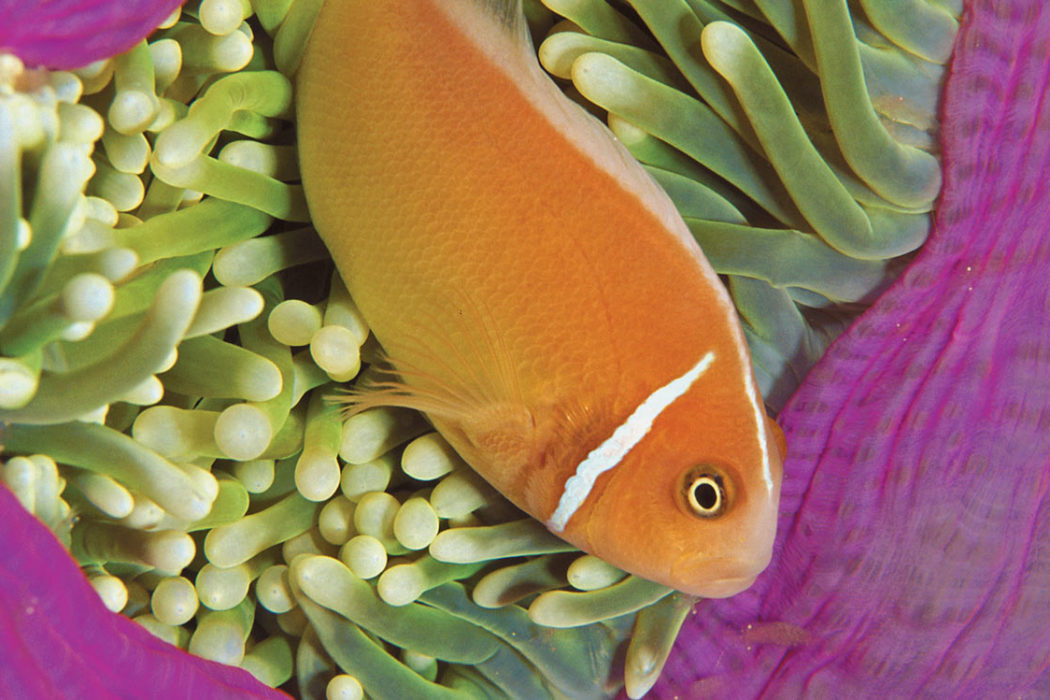After almost every dive someone grabs a reference to try and identify animals they saw. Upon flipping through the book and finding the perfect match, someone shouts out the name as others crowd around to look and verify. If a consensus is reached the gathering soon dissipates with the general feeling of “mission accomplished.”
But is it? When we identify animals in this way and go no further, we often sell ourselves short by seeing only part of the picture that was right in front of us during our dives. No marine creature lives in isolation. Every creature is part of an ecosystem of interconnected parts, and in many scenarios when you see one marine animal there is another associated species very close by.
So let’s take a look at the natural history of some creatures that some might call “odd couples,” but that the marine biologists and more experienced divers among us might think of as anything but odd or strange.
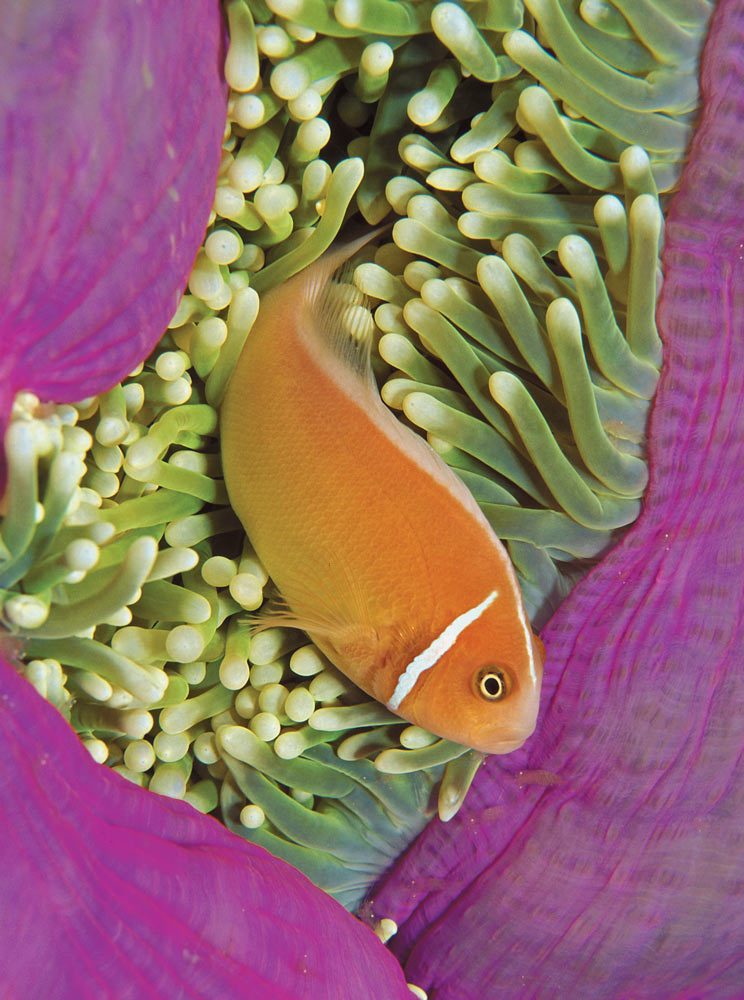
Being protected by a coat of self-produced mucus that covers their skin, anemonefishes swim freely among the tentacles without being harmed. Photo by Marty Snyderman.
Nemo Lives
Many nondivers, especially those who have seen the animated film “Finding Nemo,” and divers are aware of the relationship between sea anemones and anemonefishes. To the eyes of the casual observer anemones look like undersea flowers, but most divers soon learn that their tentacles are laced with potent stinging cells. Closely related to corals, jellyfishes and hydroids, anemones are described in the phylum Cnidaria. The distinguishing characteristic of members of this phylum is the possession of stinging cells.
As adults, most cnidarians are either immobile or they are poor swimmers demonstrating little control over their speed and direction. Their stinging cells provide anemones and other cnidarians with both a means of defense and a method of capturing prey as the toxins in the cells are both potent and fast-acting.
Dive the coral reef communities of the Indo-Pacific, and it won’t take long to come across an attention-grabbing anemonefish nestled among the tentacles of a sea anemone. It is well-known that unsuspecting fishes that blunder into an anemone’s tentacles are quickly assaulted by the near instantaneous firing of thousands of toxin-delivering, stinging cells so a mistake of this nature quickly leads to the demise of many fishes.
But what about anemonefishes? Protected by a coat of self-produced mucus that covers their skin, anemonefishes swim freely among the tentacles unharmed. How this happens is unclear. Some people believe the mucus blocks the stinging cells. Others think the anemone cannot distinguish anemonefishes from its own tentacles. In any case, the anemonefish not only remains unharmed, but also gains protection from predators that have no way to protect themselves against the anemone’s stings. It is believed that anemonefishes are beneficial to the host anemones by inadvertently dropping scraps of food that are then eaten by the anemone or by intentionally bringing food to the anemone, but this point is still being debated.
Interestingly, studies have shown that when an anemonefish is separated from its host anemone for a significant period, the fish loses its immunity and is vulnerable to an anemone’s sting if the fish comes in contact with the cnidarian’s tentacles. However, if the anemonefish is placed close to an artificial anemone, the fish loses less of its protection, leading scientists to conclude that the fish produces some of its immunity but depends upon the anemone to finish the job.
While anemones are found in tropical and temperate seas around the world, anemonefishes occur only in the waters of the Indo-Pacific.
Getting Cleaned
Big fishes eat little fishes. We have all heard that adage, but life is not always so straightforward. While it is true that smaller fishes often have to keep on the lookout for larger predatory fishes, many times a variety of small fishes, especially the juveniles, share a vital cleaning relationship with many larger fishes such as groupers, barracudas, moray eels, sharks, and manta rays as well as turtles. A number of species of shrimps also serve as cleaners.
The cleaner fishes and shrimps help rid the larger host fishes of unwelcome parasites by eating the parasites found on the skin of host fishes. In the case of sea turtles, cleaners not only remove parasites but they also remove unwanted growth from the turtles’ shells. A partial list of cleaner fishes includes a number of gobies, wrasses, butterflyfishes, angelfishes, tangs, cardinalfishes, surgeonfishes and blennies.
Cleaners often advertise their presence to attract the host fishes. Cleaner shrimps often wave their antennae to gain notice while cleaner fishes make themselves obvious by the way they swim, display or position themselves. The hosts often display in return by swimming slightly on their side, hovering in an odd attitude, quivering as they hover, or by stopping and opening their mouths and gill covers (gill slits in the case of sharks and rays) quite wide and altering their skin color to make the parasites easier to see.
Once the communication has been established the cleaners can often be seen bravely entering the wide-open mouths of their hosts to provide their services. Somehow the hosts seem to instinctively understand the value of the cleaners and leave them unharmed. In fact, studies have shown that cleaners are vitally important to the health of many reef communities, and when the cleaners are removed during studies parasites have quickly overwhelmed many previously healthy fishes.
A cleaning station is where cleaning routinely occurs. Cleaning stations are often found around prominent rock outcroppings and coral heads and around sea anemones that serve as home to cleaner shrimp. The presence of well-established cleaning stations is suspected to be one of the reasons that schooling scalloped hammerhead sharks, green sea turtles, manta rays, barracudas and other far-ranging animals return to the same reefs every day for long stretches of time.
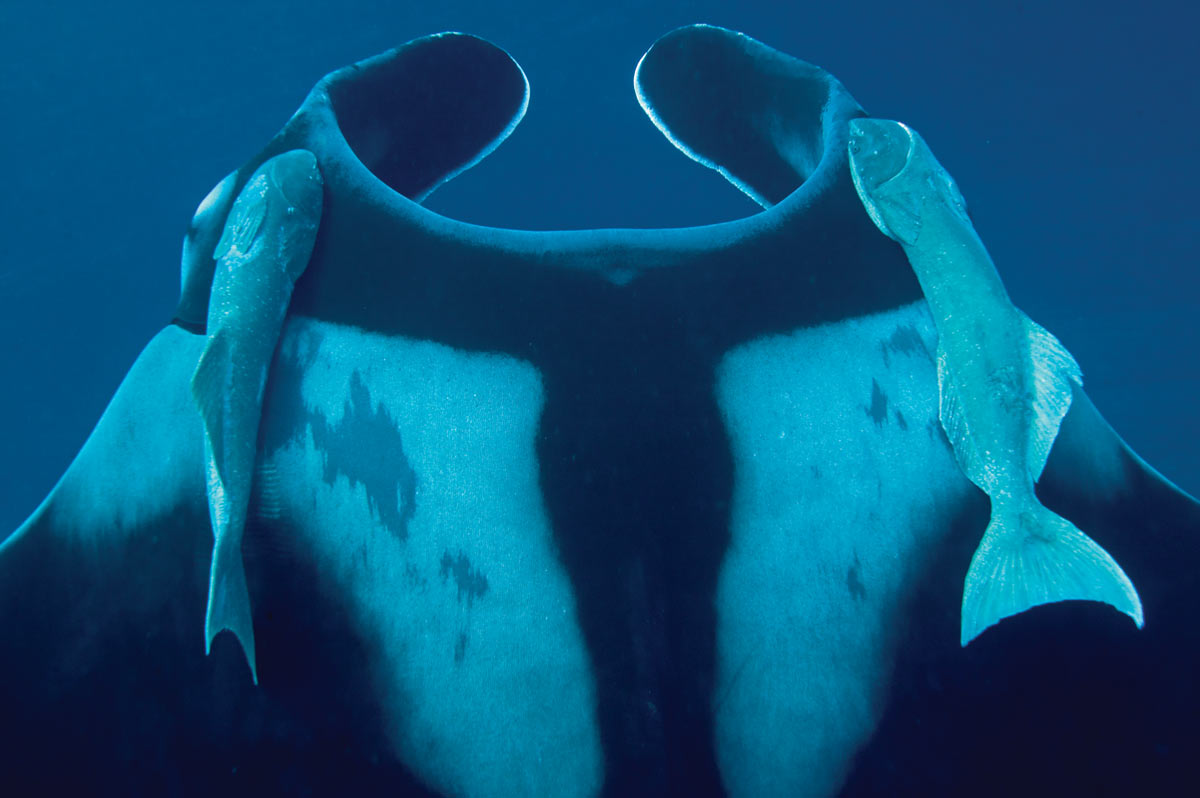
Suckerfishes such as the remoras pictured on this manta ray are also known as hitchhiker fishes because they attach themselves to a host that does the swimming while the hitchhiker fish goes for the free ride. Photo by Marty Snyderman.
Suckerfishes
Manta rays, sharks, turtles, whales, dolphins and other larger creatures are often accompanied by fishes known as remoras or sharksuckers, species that are collectively referred to as suckerfish. Suckerfishes have a flattened disc atop their head that is equipped with structures that help create suction used to attach the suckerfish to their larger host. These fishes are also known as hitchhiker fishes because they attach themselves to a host that does the swimming.
Stomach content analyses reveal that suckerfishes benefit from the relationship by gaining a food source as they readily remove parasites from their hosts. Suckerfishes are not usually all that thorough in their efforts to remove parasites. It has been suggested that the suckerfishes would run out of food if the parasites were not allowed to reproduce.
However, the relationship is more complex than just cleaning. Suckerfishes likely benefit in at least three additional ways: from eating scraps after their hosts make a kill, from the protection offered by being near a host that might be seen as a threat to animals that might otherwise harm a suckerfish, and from conserving energy, as the host does most of the swimming.
In many instances the hosts appear to welcome or, at least, easily tolerate a suckerfish, but in some instances the hosts appear to be annoyed by their presence. This certainly appears to be the case in parrotfishes that are often observed trying to scrape the suckerfish against the reef to dislodge the unwelcome riders from their body.
Assisted Living
In many locales throughout the Indo-Pacific a variety of fishes known as partner gobies share their burrows with several species of blind shrimps. In each burrow at least one shrimp excavates and maintains the burrow, winning the neighborhood’s good housekeeping award while the goby keeps a vigilant eye out for threats. The shrimp literally keeps in touch with the goby, placing at least one of its antennas on the fish’s body.
The gobies can move their eyes independently and are well-equipped to serve as lookouts. If the goby senses danger the fish quickly retreats into the burrow. The blind shrimp follows in the blink of a human eye. In many species of gobies and shrimps that are known to participate in this relationship, adults of both species are never seen without the other species.
Eating Your Home
In some instances the relationship between members of different species is as simple as that of predator and prey. That is the case with the commonly seen flamingo tongue snail and the less frequently encountered fingerprint snail found on sea fans, sea whips and other soft corals in the Caribbean and associated waters. Unimpeded by the stinging cells of the corals, the snails readily prey upon the tissues of the corals leaving a visible trail where the tissue of the coral has been eaten away.
In many other instances the snails that feed on soft corals are colored to blend in, but that is not the case with the eye-catching flamingo tongue and fingerprint snails.
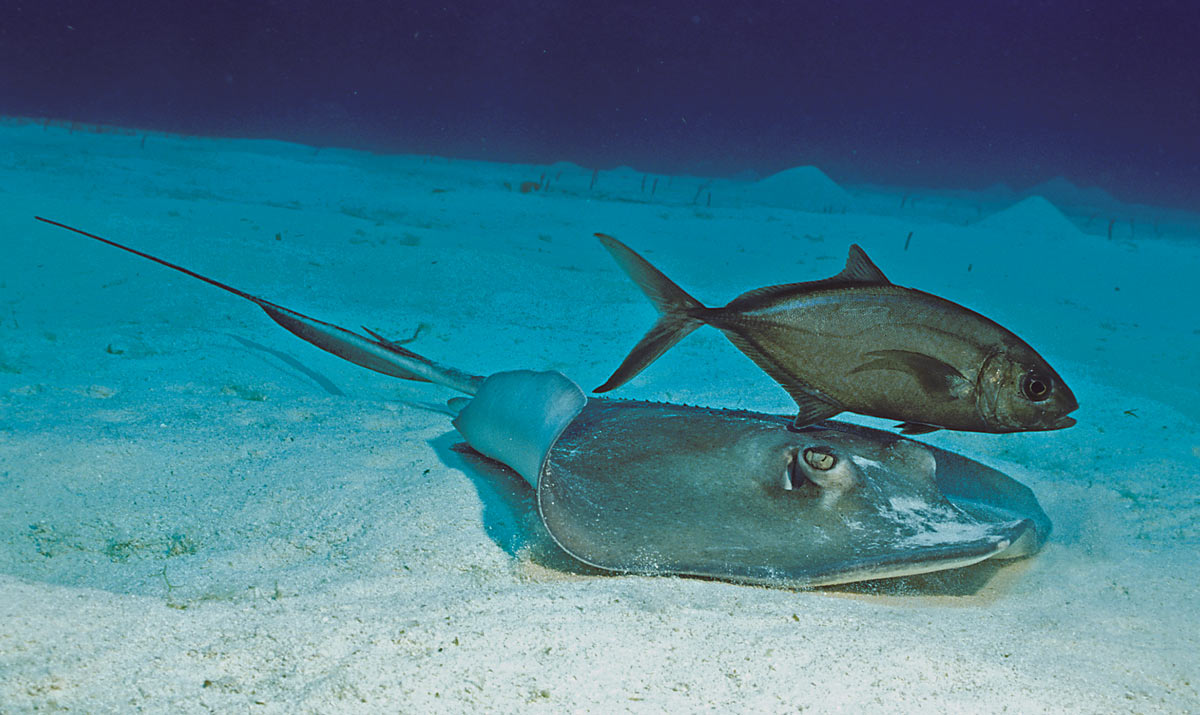
Southern stingrays are often accompanied by bar jacks when the rays are searching for food and feeding in sand flats. The rays prey upon clams and other mollusks they dig out of the sand. The jacks are able to scavenge upon scraps overlooked by the rays and to capture other prey items that are uncovered by a ray as it digs through the sand. Photo by Marty Snyderman.
Stingrays and Jacks
A variety of jacks routinely associate with several bottom-dwelling stingrays such as the southern stingray that is commonly encountered in the Caribbean and associated seas. Southern stingrays are often accompanied by bar jacks when the rays are searching for food and feeding in sand flats. The rays prey upon clams and other mollusks they dig out of the sand. The jacks are able to scavenge upon scraps overlooked by the rays and to capture other prey items that are uncovered by a ray as it digs through the sand. Without a ray, a jack would not be able to find or dig the mollusks out of the sand. Bar jacks routinely school, but turn solitary and highly protective of their “turf” when associating with a feeding stingray. Other fishes, especially a variety of wrasses, also associate with feeding stingrays.
Recognizing and understanding various relationships that exist between marine species will enable you to do a lot more than just identify and learn the names of marine animals. Knowledge about these relationships will provide you with a much better understanding of the marine kingdom and help you see a lot more during your dives. No doubt about it, the more you know about the creatures you encounter the richer your diving experiences will be.
Big Fish, Little Fish
Anyone who has watched a shark-themed show on television has probably seen footage of big sharks pursuing little fish. But it might come as quite a surprise during a dive to see a number of small fish gathered only inches in front of a relatively large shark such as a Caribbean reef shark, blacktip or even a whale shark, the world’s largest fish. But it happens a lot.
In some instances the small fishes mob the shark, rubbing themselves against the sandpaper-like skin of the shark to dislodge parasites. In other instances juvenile jacks and pilotfish swim just inches in front of a shark’s face. One of the more commonly accepted theories as to why the small fish choose what appears to be such a dangerous location is that the small fish use the pressure wake created by the shark to conserve their energy when swimming. Another theory states that these small fish only have to keep an eye on one predator as it seems unlikely that any other predator would risk coming so close to the shark.
Still another theory suggests that the small fish benefit by being able to pick up scraps after the shark makes a kill while the shark benefits from the presence of the fish by having the small fish around to help find sources of food. In essence, the shark and its entourage work together as a single food-seeking sensory system.
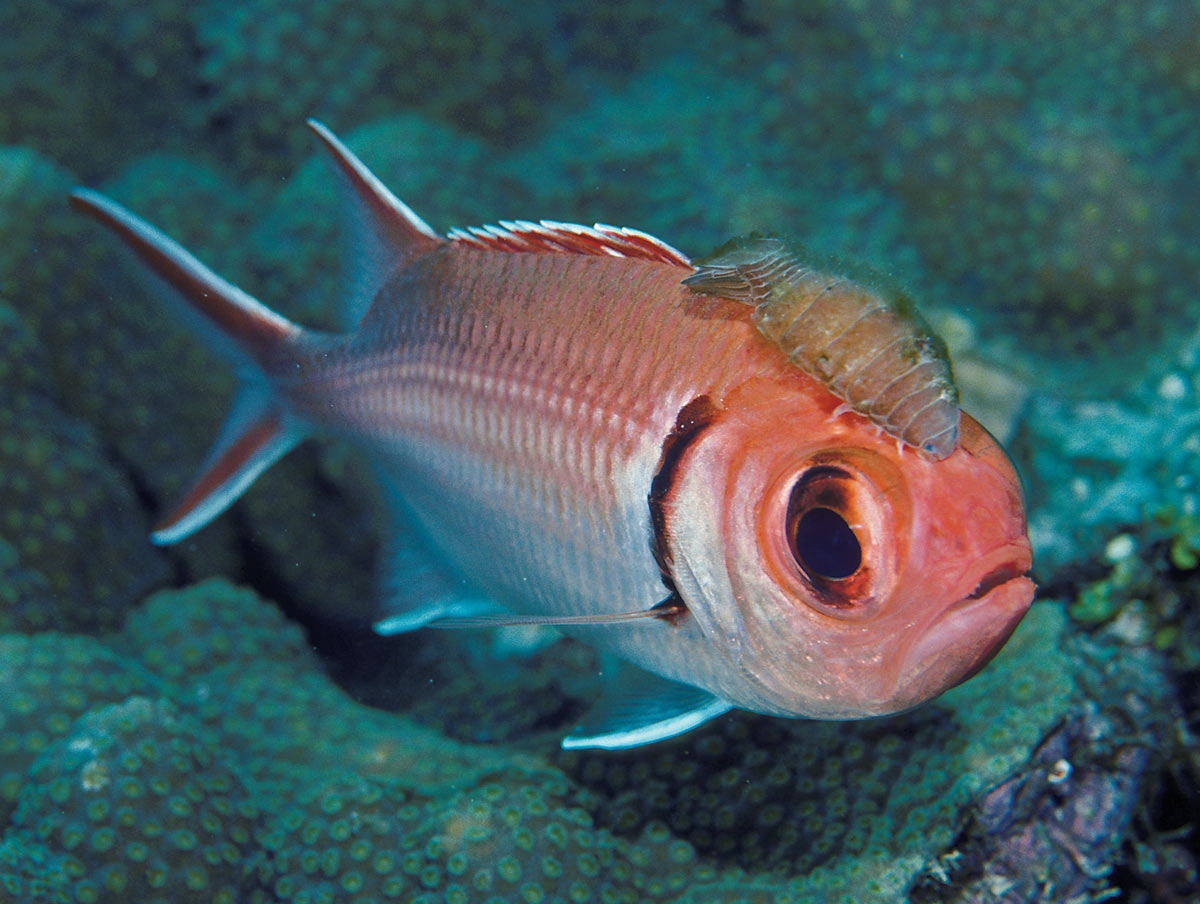
Photo by Marty Snyderman.
Appearances Can Be Deceiving
The relationship between isopods and blackbar soldierfish is often misunderstood. Many people believe the isopods to be parasites that feed on the skin of the soldierfish, but this is not the case. This Caribbean fish often carries around one rather unattractive, relatively large, female rider known as an isopod as well as a bunch of far-more-difficult-to-see smaller male isopods. The female digs into the flesh of the soldierfish with her claws, and her presence looks painful. Yet, she causes little more than a flesh wound, as she does not feed on the skin of the fish as is often believed. Instead she uses the fish as a platform from where she can snag bits of food out of the water column. The female emits chemicals that prevent any of the males from transforming themselves into a female, but if she is removed from the soldierfish one of the males rapidly transforms itself into a larger female.

